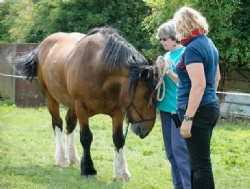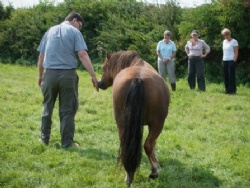Our Survey says...
A group of four people chose to explore ‘Staff Surveys’ to find a solution to engage the workforce in the process. They considered there was a lack of staff confidence that anything worthwhile would result from the surveys.
The Equine Coach invited the group to contemplate what was needed to achieve staff engagement in the survey process. As a result, they agreed that they needed to build momentum with consistent and frequent communication and interaction with the workforce.
Their obstacles in the arena involved a series of poles, spaced at regular intervals, for them to walk over with the horse at a fast pace.
One member of the group led our Welsh cob, Sam. Taking hold of the lead-rein, they walked forwards with Sam following at a distance. They walked several meters away from the poles to try to get enough space to build up speed and lead him over. But each time, Sam moved slowly, keeping a distance behind them and barely increasing his pace.
The group invested a lot of time in discussing the situation, to design and build the structure that
represented their obstacle, leaving little time to complete the activity of walking over the poles. Added to this, Sam was distracted and didn’t engage with the group members; this was the only time that this happened during the whole two-hour event. The horse’s lack of engagement was particularly symbolic of the scenario that the group had chosen to explore.
The most poignant moment that served as a key learning point for the group was what happened next... When Sam worked with the next group, the first thing a member of group did was to speak very clearly to him, using his name and stroking his head. Instantly, Sam transformed into an alert state and worked with a higher level of energy than before.
Their Key Learning Points:
- The group recognised that it’s possible to invest too much time studying the systems involved in a process, at the expense of ignoring the workforce.
- The distance between the horse and the person leading the horse meant that Sam wasn’t working in harmony or at the same pace – yet another metaphor, representing the negative impact of keeping too much distance between staff and management.
- Engaging the workforce requires personal contact and may well benefit from offering recognition and reward for efforts, (stroking the horse was agreed to represent a form of reward).
- Time and Resources are restrained, which limits the potential to succeed in this task.
- Future approaches to engaging the workforce require more resources.
Personal Revelations: The group members had all made assumptions, at the outset of the task, that it wasn’t possible to succeed in engaging the workforce. Consequently, they chose to focus on systems rather than continuing to interact at a personal level with the workforce.
Resulting Actions: They would review plans for the next staff survey and re-assess the resources needed to succeed, including ways to interact with the workforce at a personal level. They would also design frequent and consistent interactions to provide regular updates for the workforce, highlighting achievements that have resulted from survey contributions.

